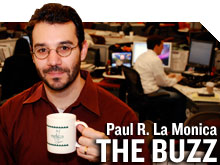The greenback has slid as investors flood back into stocks and commodities on end of recession hopes. But shouldn't a recovery be good news for the dollar?


NEW YORK (CNNMoney.com) -- The dollar goes down. Stocks go up. Lather. Rinse. Repeat.
One constant during the market's big rally -- now nearing its sixth month -- is that the greenback has taken a hit against the euro, yen and other currencies.
But some experts think that may be about to change. Stocks and the dollar could begin to move in the same direction. In fact, the dollar was up slightly Monday even as stocks once again moved higher.
It's been a strange ride for the greenback over the past year. The dollar rallied sharply from last fall until early March of this year -- even though that was the peak of the financial panic.
The thought was that investors were fleeing risky assets like stocks and commodities and plowing into the dollar, which, despite the many woes facing the U.S. economy, was still perceived as a safe place to park money.
But now that everybody on Wall Street is falling over themselves to declare that the recession is over, the dollar has begun weakening again as people sell dollars to invest in stocks, oil and other currencies.
Vassili Serebriakov, currency strategist with Wells Fargo, said this type of trade may not last for much longer though.
He said it made sense for the dollar and stocks to move in opposite directions during the height of the recession. But if the downturn is really nearing an end, investors should soon conclude that an economic recovery is good news for the greenback.
"Even if stocks do rally further, that may not be a negative. The dollar could stabilize because the U.S. economy is stabilizing," he said. "The gains in the stock market are a vote of confidence by international investors and at some point that should be a positive for the dollar."
A rebound in the dollar would be welcome news for consumers. The price of oil has marched higher in the past few months. Part of that is due to the recovery hopes but the weak dollar is also a culprit as well since oil is priced in dollars. Therefore, any time the dollar goes down, that usually leads to oil going up.
For that reason, Brian Dolan, chief currency strategist for FOREX.com, said that he thinks there are limits to how far the dollar could weaken. If the dollar falls significantly further, the resulting spike in crude prices could lead to renewed questions about whether the recession is really close to its final stages.
"The biggest drawback with a weaker dollar is what it would do with commodity prices. We know what that does to gas prices and consumers. It could short-circuit a global recovery," he said.
Dolan added that another reason the dollar hasn't bounced back yet is because of momentum. It's now the sleepiest part of the summer. With trading volume so light, investors are unwilling to make any bold calls -- so that just leads to a continuation of the existing trend.
"The dollar has been the easy punching bag this summer," he said. "When the market returns to more normal conditions in the fall, there should be more diversification and people will move out of what's been the easy trade."
Omer Esiner, senior currency market analyst at Travelex Global Business Payments, a foreign exchange specialist, agreed that the dollar could stabilize in the fall once traders return from the beach.
But Esiner doesn't think the dollar and stocks will head higher in tandem. Rather, he believes a reversal of the summer stock rally and return to less risky assets will boost the greenback.
"A potential correction in stocks could be on the way and that should lead to a stronger dollar," he said. "Wall Street is factoring in a pretty rapid pace of recovery. Inevitably, there will be disappointment when the actual rebound undershoots the market's expectations."
Esiner added that any recovery for the dollar could be short-lived because investors may once focus on how costly the U.S. government's stimulus efforts are.
The Treasury Department is busy issuing new debt while the Federal Reserve has pumped a lot of cash into the financial system to try and jumpstart the credit markets. Esiner isn't expecting a wholesale collapse of the dollar, but he does think this printing of money will take its toll on the dollar's value.
"The key risks for the dollar are more long-term, not least of which are the soaring deficits in the U.S. and the deteriorating fiscal backdrop," he said.
But Dolan doesn't buy that argument. He thinks investors will instead soon realize that the U.S. isn't the only country trying to spend its way out of the downturn.
"The dollar has been to hell and back this year. Its status as the global reserve currency has been questioned. But we're not alone in issuing a lot of debt -- and the U.S. still has the ability to attract foreign investments," he said.
That may not hold true indefinitely. But for now, it does seem like the dollar's worst days may be behind it.


No comments:
Post a Comment